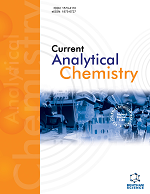- Home
- A-Z Publications
- Current Analytical Chemistry
- Previous Issues
- Volume 19, Issue 9, 2023
Current Analytical Chemistry - Volume 19, Issue 9, 2023
Volume 19, Issue 9, 2023
-
-
Nanotechnology-based Assays for the Detection of Cancer through Sputum
More LessCancer remains a formidable global health challenge, underscoring the critical need for early and accurate diagnostic tools. In recent years, nanotechnology has emerged as a promising frontier in cancer detection, offering innovative approaches to enhance sensitivity, specificity, and convenience in diagnostics. This comprehensive review delves into the intersection of nanotechnology and sputum-based assays for can Read More
-
-
-
Dengue Fever Virus Envelope Glycoproteins Variability Characterized Bioinformatically
More LessBackground: The infection caused by the dengue fever virus is a severe threat to public health on a global scale; nevertheless, there is currently no effective medical treatment or vaccine available to prevent or treat the condition. Objective: To better understand the physicochemical regularities of these proteins, it is necessary to carry out a computational multiparametric study of the amino acid sequences of envelope proteins e Read More
-
-
-
Enhancing the Bioavailability of Silymarin Phytopharmaceutical by using Piperine and Fulvic Acid and Simultaneously Quantifying Three Biomarkers in Plasma
More LessAuthors: Tanya Ralli, Zoya Saifi, Zakiya Usmani, Vidhu Aeri, Mohd. Aqil and Kanchan KohliBackground: Silymarin (SM) is a mixture of seven flavonolignans (FL) and one flavonoid extracted from the seeds of the milk thistle plant. The major FLs include silibinin, silychristin, silydianin, and isosilibinin. Silibinin, a mixture of two diastereomers, i.e., silybin A and silybin B, has been found to be the most active biomarker molecule in the extract of SM. Some studies have also demonstrated the usefulness of other biomarkers. Ho Read More
-
-
-
A Novel Fluorescent Aptasensor Based on Mesoporous Silica Nanoparticles for Selective and Sensitive Detection of Saxitoxin in Shellfish
More LessBackground: Saxitoxin (STX) stands as one of the most potent marine biotoxins, exhibiting high lethality. Despite its severity, current treatments remain ineffective, and existing detection techniques are limited due to ethical concerns and technical constraints. Methods: Herein, an innovative approach was constructed for STX detection, utilizing mesoporous silica nanoparticles (MSN) as a foundation. This innovative, easy, and Read More
-
-
-
Study on Separation Mechanism of Ephedrine and Pseudoephedrine in Borax Buffer by Capillary Electrophoresis
More LessAuthors: Jinqiu Xu, Yinhua Gong, Rongrong Huang, Liangliang Cai and Xiaofei MaBackground: In borax buffer, ephedrine (EPH) and pseudoephedrine (PSE) can be well separated (Rs>10) in capillary electrophoresis (CE) without adding any other compounds, but the specific mechanism remains unclear. Methods: Titration analysis, nuclear magnetic resonance analysis, mass spectrum analysis and molecular modeling were used to investigate the separation mechanism. Results: Tetrahydroxy borate (a hydroly Read More
-
Volumes & issues
-
Volume 21 (2025)
-
Volume 20 (2024)
-
Volume 19 (2023)
-
Volume 18 (2022)
-
Volume 17 (2021)
-
Volume 16 (2020)
-
Volume 15 (2019)
-
Volume 14 (2018)
-
Volume 13 (2017)
-
Volume 12 (2016)
-
Volume 11 (2015)
-
Volume 10 (2014)
-
Volume 9 (2013)
-
Volume 8 (2012)
-
Volume 7 (2011)
-
Volume 6 (2010)
-
Volume 5 (2009)
-
Volume 4 (2008)
-
Volume 3 (2007)
-
Volume 2 (2006)
-
Volume 1 (2005)
Most Read This Month
Article
content/journals/cac
Journal
10
5
false
en


